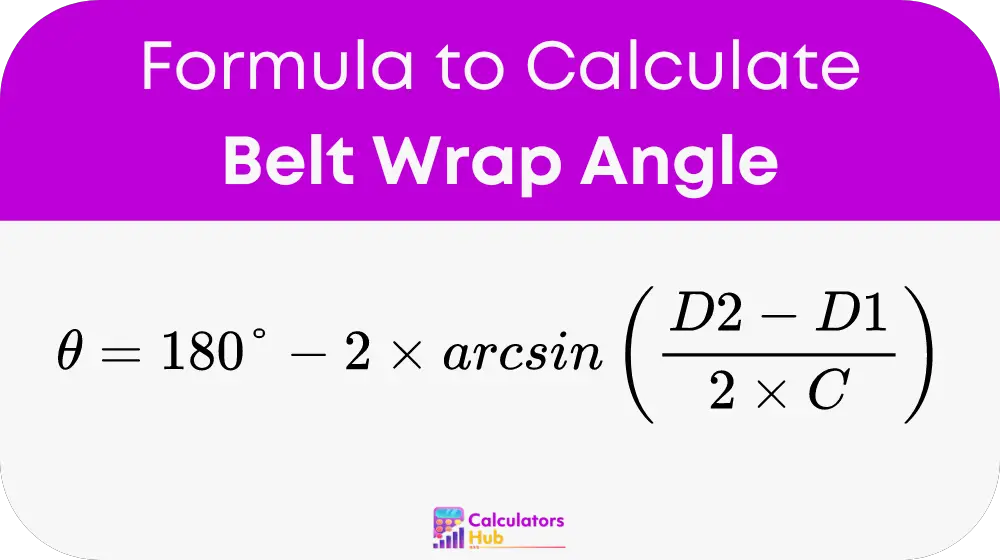The Belt Wrap Angle Calculator is a specialized tool used in mechanical engineering to determine the wrap angle of a belt around a pulley system. The wrap angle is critical in understanding the amount of contact between the belt and the pulley, which directly influences the efficiency of power transmission and the potential for slippage. A greater wrap angle generally results in better grip and reduced slippage, which is essential for ensuring the smooth operation of belt-driven machinery.
This calculator is particularly useful in the design and maintenance of belt-driven systems, such as conveyor belts, automotive engines, and industrial machinery. By accurately calculating the wrap angle, engineers and technicians can optimize the performance of the system and prevent issues related to belt slippage and wear.
Formula of Belt Wrap Angle Calculator
The wrap angle of a belt around a pulley can be calculated using the following formula:

Where:
- θ is the wrap angle in degrees.
- D1 is the diameter of the smaller pulley, measured in the same unit as D2.
- D2 is the diameter of the larger pulley, measured in the same unit as D1.
- C is the center distance between the two pulleys, measured in the same unit as D1 and D2.
- arcsin is the inverse sine function, which calculates the angle whose sine is a given number.
This formula provides a precise measurement of the wrap angle, allowing users to assess and adjust the belt tension and pulley alignment for optimal performance.
Useful Conversion Table
To assist with common calculations related to belt wrap angles, the following table provides typical values and conversions that are frequently used in mechanical systems.
| Term | Description | Common Values |
|---|---|---|
| Diameter of Smaller Pulley (D1) | The diameter of the smaller pulley in the system. | 50mm, 100mm, 150mm |
| Diameter of Larger Pulley (D2) | The diameter of the larger pulley in the system. | 100mm, 200mm, 300mm |
| Center Distance (C) | The distance between the centers of the two pulleys. | 500mm, 750mm, 1000mm |
| Wrap Angle (θ) | The angle at which the belt wraps around the pulley. | 120°, 150°, 180° |
These values provide a starting point for users to input data into the Belt Wrap Angle Calculator and interpret the results more effectively.
Example of Belt Wrap Angle Calculator
Let's consider an example where you need to calculate the wrap angle for a belt system with the following parameters:
- Diameter of Smaller Pulley (D1): 100mm
- Diameter of Larger Pulley (D2): 200mm
- Center Distance (C): 500mm
Calculation
Using the formula:
θ = 180° - 2 * arcsin((D2 - D1) / (2 * C))
Substitute the values:
θ = 180° - 2 * arcsin((200mm - 100mm) / (2 * 500mm)) = 180° - 2 * arcsin(100mm / 1000mm) = 180° - 2 * arcsin(0.1) = 180° - 2 * 5.74° = 180° - 11.48° = 168.52°
The wrap angle is approximately 168.52°. This angle indicates that the belt wraps almost entirely around the pulley, providing a good amount of contact and reducing the likelihood of slippage.
Most Common FAQs
The wrap angle is crucial because it determines the amount of contact between the belt and the pulley. A larger wrap angle generally means more contact, which helps prevent slippage and ensures efficient power transmission. This is essential for the smooth operation of machinery and the longevity of the belt.
Yes, the Belt Wrap Angle Calculator can be used for various types of belts, including V-belts, flat belts, and timing belts. The formula is applicable to any belt and pulley system where the wrap angle needs to be calculated to ensure proper operation.
To increase the wrap angle, you can adjust the center distance between the pulleys or use an idler pulley to guide the belt more closely around the driven pulley. Increasing the pulley diameter can also contribute to a larger wrap angle, improving belt grip and reducing slippage.